New Leaf Agriculture’s year-old community farmer program empowers a diverse group of immigrants to raise culturally desired crops by providing them with land, tools, training and income.
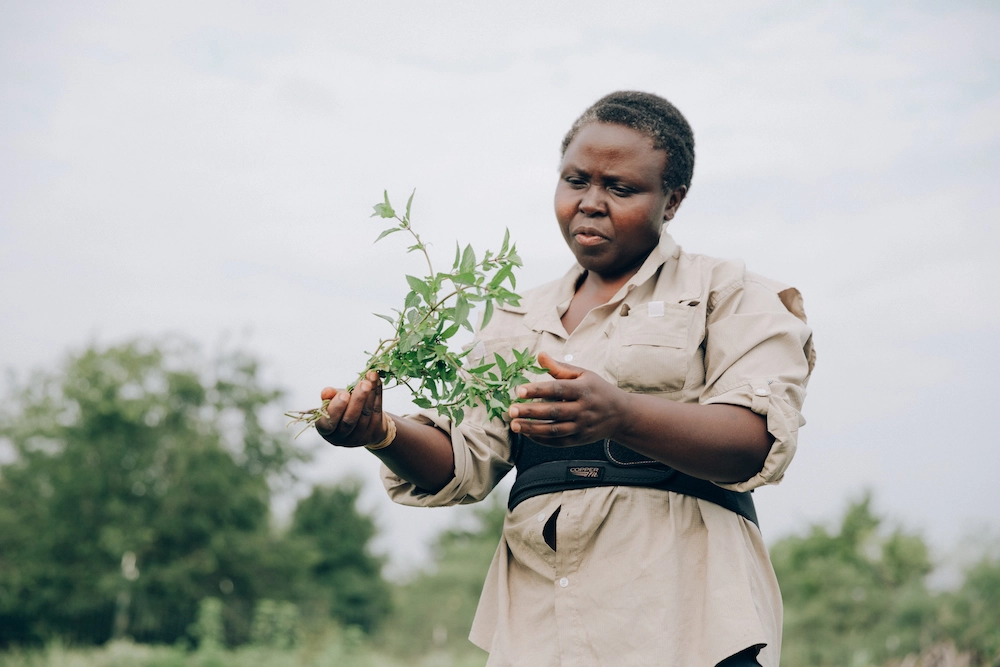
Krishna Bista grew up on a diversified farm in her native Bhutan, where her family cultivated sweet potatoes, ginger, corn, wheat, millet, citrus and cardamom. At age 30, she was forced to seek asylum in Nepal, and for the next 19 years, she was unable to work or grow her own food.
“I had to rely on others to eat, and it was really difficult,” says Bista, who is one of six refugee farmers employed by New Leaf Agriculture, a 20-acre organic operation located in Manor, Texas. “I’m happy now, because I can feed myself and I have friends and a support system, thanks to New Leaf.”
When Bista was granted refugee status in 2010, she began taking English classes at Central Presbyterian Church in Austin, 14 miles west of Manor. It was there she met Meg Erskine, co-founder and CEO of the Multicultural Refugee Coalition (MRC), the non-profit that oversees New Leaf and a textile manufacturing studio located at the church.
MRC’s two social enterprises were created to provide refugees and asylees from traditional farming and sewing cultures with training and dignified employment that reconnects them to their respective vocations. “Working with these people every day, it’s very clear that self-sufficiency is in their blood,” says Matt Simon, New Leaf’s agricultural director. “Being able to take back some control over their lives when they’ve previously had none is empowering.”
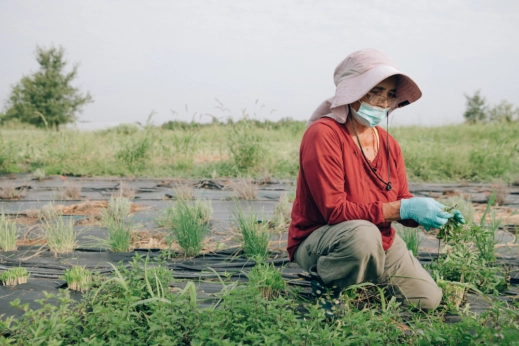
Krishna Bista grew up on a diversified farm in her native Bhutan. (Photo courtesy Leia Vita/Farmers’ Footprint)
The public-facing farm, which was established in 2017, employs refugee farmers to cultivate crops for its CSA, Austin’s Mueller and Lakeline farmers’ markets and local restaurants and makers. New Leaf helps refugees who aren’t employees by donating 90 of its CSA shares per week to families in need, in partnership with the Center for Survivors of Torture and the Austin Independent School District.
New Leaf also runs a community farmer program, established in the fall of 2022, that provides refugees with small plots and supplies so they can cultivate their own culturally desired crops. With grant funding from Travis County, New Leaf purchases all of these crops (including those consumed by farmers and their families) and distributes them free of charge within their respective communities.
The benefits of helping displaced immigrants become self-sufficient after years of instability are many. “Most social enterprise programming is focused on life skills and job placement,” says Simon. “This is different because we’re actually providing them with the assets they need to feed their families. Our goal for this program is to endow and equip our farmers with the skills and knowledge necessary for running their own farming business, should they choose to do so.”
For Doli Wikongo, a refugee farmer employee who grew up cultivating bananas and rice in her native Congo, New Leaf has been a lifeline. “[It’s] helped me to assimilate greatly,” she says. “The farm is a community of immigrants, mostly from Africa and Asia. We’re culturally similar because we traditionally grow the same crops, share resources and live in big, family-oriented groups, so we see one another as extended family.”
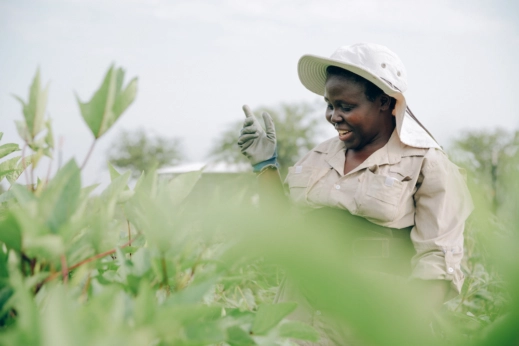
Doli Wikongo at New Leaf Agriculture’s farm. (Photo courtesy Leia Vita/Farmers’ Footprint)
After arriving in the US in 2013 with her five children, Wikongo and her teenaged son Wandaka began volunteering at Farmlink, MRC’s predecessor to New Leaf. The agricultural partnership was located at Austin’s Green Gate Farms and provided a way for refugees from farming cultures to keep their hands in the soil and receive free produce in exchange for several hours’ of work each week.
It was Wandaka who ultimately became the catalyst for New Leaf in 2017, says Simon. The then 17-year-old was also involved with Future Farmers of America through his high school and knew well the importance of agricultural programming for refugee immigrants. In early 2017, the owner of Green Gate Farms introduced Wandaka to a local grower who was leasing land from a man named Jon Beall.
“Wandaka noticed that there was quite a bit of unutilized land on Beall’s property, so he asked Jon if MRC could lease the acreage,” says Simon. “Jon was happy to do so, and our first growing season was the spring of 2018. Wandaka, who is now attending university in France, was our first farm manager.”
Doli Wikongo and Bista were also two of New Leaf’s first refugee farmer employees. The women are now crew chiefs for the public farm program and oversee four other refugee farmers from Burma and Congo. Together, the farm crew cultivates and harvests more than 50 different crops including heirloom peppers, melons, summer and winter squash, okra, greens, brassicas and botanicals such as Mexican mint marigold, which is used as a textile dye.
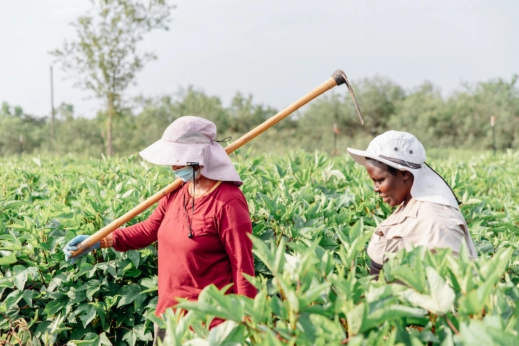
Wikongo and Bista oversee the farm crew. (Photo courtesy Leia Vita/Farmers’ Footprint)
The starting pay for refugee farmers is “competitive with other certified organic farms in the region and actually higher than some small, family farm managers make,” says Simon. “We also give yearly raises and paid time off.” The farmers also receive twice-weekly in-house ESL classes and regular meetings with MRC’s case manager. To help them navigate health care and other benefits, New Leaf connects the farmers to relevant local organizations such as Foundation Communities and Manos de Cristo.
New Leaf launched its community farmer program in the fall of 2022 as a way for refugees to grow their own food and earn supplemental income. Each of the 24 community farmers, including Bista and Wikongo, are allocated a 750-square-foot plot along with farm implements and organic fertilizer; they come from traditional farming cultures including Congo, Burma, Afghanistan, Bhutan, Nepal and Bangladesh.
The community farmers grow culturally desirable crops such as amaranth, various types of eggplants and peppers, red noodle beans, roselle hibiscus and more. Bista cultivates daikon radish, brassicas, kale, beets, winter squash and blisteringly hot Dalle Khursani peppers, which she adds to gundruk, a fermented dish made from the leaves of mustard greens or cauliflower. Bista uses daikon for achar, a pickle flavored with various spices and chiles. “I mostly make vegetables and pickles,” she says. “It makes me very happy to eat the food I had growing up in Bhutan.”
Bista’s son Bal is New Leaf’s chicken and greenhouse manager, and he and his in-laws also have community farmer plots. Any leftover crops not used by the Bistas and their relatives are given to their neighbors.
Wikongo and her two teenaged daughters grow cauliflower, cabbage, green onions, various greens and winter squash. She uses the leaves from the squash for bishusha, a dish traditionally made with pumpkin greens. After boiling the leaves to remove their thorny outer layer, she cooks them with tomatoes and a bit of heavy cream, to be served over rice.
“If I have enough vegetables to feed my family, I’ll give the rest to my friends or sell it back to New Leaf,” says Wikongo. “We have a Congolese community here in Austin and New Leaf delivers food to one of our churches.”
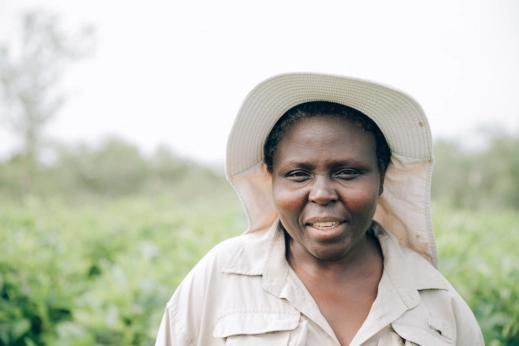
Wikongo and her daughters grow cauliflower, cabbage, squash and more. (Photo courtesy Leia Vita/Farmers’ Footprint)
Mang Thian Cing, a refugee from Burma, grows roselle hibiscus, among other crops, on her allocated land. The plant’s tart flowers are used for tea in Burma, and the lemony-tasting greens (known as chin baung hin ywet, or sour leaf), are added to soup or used in chin baung kyaw, fried roselle leaves and bamboo shoots flavored chiles, onion, shrimp paste and fish sauce.
Learning to farm in a climate like Texas’s is challenging, even for farmers like Wikongo who are from tropical regions, because there are differences in botany and methodology, she says. “In Congo, the seeds are bigger, so we just plant them in the ground. Here, the seeds are smaller and it’s necessary to start them in a greenhouse.” She has also learned to mix and amend soil and place irrigation pipes in a way that maximizes water distribution.
Despite the climatic extremes and lack of consistent rainfall, Wikongo loves farming and considers it her permanent vocation. “It’s what I want to do,” she says. “If you work in the fields, it keeps you active and healthy. I’m able to do so much more.”
Learn more at mrcaustin.org